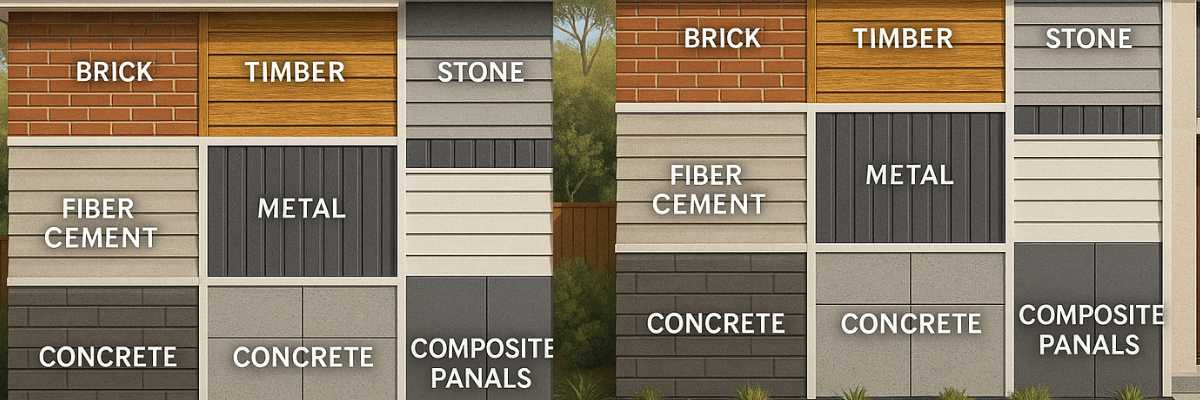In the sphere of remodelling, there are not many changes that can bring as dramatic a shift as cladding can. This interior and exterior treatment; which could be described as an application of a protective layer on the walls of your home, transcends simple aesthetics. Cladding does not only beautify property but brings many advantages to long-term staying as well as the valuation of properties.
When homeowners are searching for a material that will protect their house, save energy and look elegant, cladding steps forward. Finishing the inner and outer surfaces of your home provides a comprehensive approach to the desired modernization of the housing, its performance increase, as well as simplification of the maintenance process. Check here a detailed list of benefits that come with the use of cladding including its functions as a shield and insulator, one that elevates the value of your property and its aesthetic value as well. When you consider all the versatile advantages of cladding, it will be easier for you to make the right decision regarding this worthy investment.
1. Enhanced Durability and Protection:
a. Weather Resistance:
Homeowners benefit from cladding as it provides them with resistance to harsh weather conditions as one of the main rewards. Different cladding materials, such as vinyl, metal, fibre-cement, and wood, are engineered to withstand various elements:
Rain and Snow: In particular, cladding provides some level of protection against moisture, and thus minimizes the chance of moisture penetrating the façade and causing mould, rot and other damage to the building’s structure. For instance, fibre cement cladding proves to be quite resilient to matters of rain and snow as it does not degrade under weather elements.
Wind: Wind storms are prevalent during winter and they tend to destroy some parts of a building especially when the walls are not covered. Cladding systems are created to remain firmly anchored and wind-driven rain cannot penetrate through it and jeopardize the stability of the structure.
UV Exposure: A lot of direct exposure to sunlight leads to fading and wearing off of outer finishes. Some of the cladding materials are coated with UV stabilizers that help in covering up the effects the sun has on the cladding hence enabling you to get the best look and durability of the cladding.
b. Impact Resistance:
Physical impacts can also be greatly mitigated by human beings through the use of cladding. This is especially advantageous when applied in locations that are common targets of hail, falling debris through a tree, or even an accidental knock from conventional outdoor activities.
Metal Cladding: It incorporates the strength and impact resistance and can therefore withstand hail storms and other related impacts that may make it dent or crack.
Composite Materials: These materials sometimes enhance the strength with flexibility allowing for protection from impacts while being lighter.
c. Pest Protection:
Some materials used in cladding also provide restriction of pest access and presence in homes. Termites and rodents especially attack wooden structures and can easily bring down our traditional wooden siding but with new cladding materials like metallic or composite ones these pests stay off. Also, post-FR cladding systems containing barrier or treatment mechanisms can avoid pest penetration.
2. Improved Energy Efficiency:
a. Enhanced Insulation:
Another local incentive for cladding investment, one of the most attractive, is the enhancement of your home’s thermal efficiency. Many cladding systems include or can be combined with insulation materials, leading to several benefits:
Temperature Regulation: Through the construction of a good thermal barrier, cladding assists in controlling indoor temperatures thereby minimizing the utilization of too much energy for heating systems or air conditioning. This can in turn create a more convenient living environment or should I say comfortable living atmosphere all around the year.
Reduced Energy Consumption: They provide better protection against heat loss during winter and heat gain during summer and this means you can use less energy and hence incur less energy costs. For instance, the insulated cladding system will help contain and retain heat during the cold season and hot air during summer thus helping to cut down on heating and cooling costs respectively.
b. Environmental Impact:
Efficiency in the utilization of energy to enhance your home also has the benefit of reducing the impact on the environment. This in turn means that, through the use of less energy, one helps to lessen the negative impact on the environment hence living an environmentally friendly life. Many cladding materials are designed with eco-friendly attributes, such as:
Recycled Content: Some of the cladding types contain recycled content, for instance, composite material products, thus decreasing the consumption of virgin materials as well as cutting down on waste production.
Energy Savings: Less energy used will equate to fewer greenhouse gases generated by power-generating companies, hence contributing positively to the reduction of greenhouse gas emissions that cause climate change.
c. Cost Savings:
Even though the cost of cladding material is a bit high as compared to traditional siding materials, one is likely to save a lot of money on energy bills. The energy efficiency can be enhanced over time which will mean economic gains and proves that cladding is cheaper in the long run.
3. Low Maintenance Requirements:
a. Minimal Upkeep:
However, there are certain aspects of cladding, for example, it has very low maintenance needs as compared to other exterior finishes. This is especially useful to homeowners who wish to save the time and money that they spend maintaining their homes. Key aspects include:
Durable Finishes: Most cladding materials such as metal, fibre-cement and other high-quality composites are aimed at being durable and they do not wear out or get affected by factors like rotting, peeling and fading.
Easy Cleaning: Most cladding systems are developed to have long-term low maintenance as well as easy to clean. For instance, with metal cladding one can only wash them with soapy water once in a while compared to vinyl cladding which only needs a hose to wash them at a given instance.
b. Longevity:
This is because most cladding materials usually have longer service life thus less frequent repairs and replacements. For example:
Metal Cladding: Because of its life span, which may extend up to fifty years or more, metal cladding requires negligible maintenance and is inherently immune to abrasive influences of the environment.
Fiber-Cement Cladding: This material is quite durable and does not have some common problems such as termite infestation and thus requires little maintenance.
c. Reduced Repair Costs:
This is because cladding shields the components beneath them from contact with the climate thus making them slower to deteriorate thus they do not need constant repair. When repairs are required they are usually simple, and the cost of doing this is relatively lesser compared to other siding materials. For example:
Composite Cladding: Built with modular panels in most instances, localized areas can be repaired using replacement panels hence making it easier to repair the facility.
4. Aesthetic Appeal and Customization:
Designs that reflect cutthroat contemporary commercial look and feel, also known as sleek designs. Cladding offers many different options where you can bring the look of your home to the next level. Whether you’re looking for a modern, sleek look or a classic, timeless aesthetic, cladding materials offer versatile options:
Contemporary Styles: There are more advanced cladding materials available in the market such as metal and composite panels with modern and urban design that gives your home that convoy of modern housing.
Traditional Finishes: For a more conventional look the use of timber or stone cladding automatically brings in the ambience and feels of the old world houses.
b. Customization Options:
Cladding can be highly flexible and therefore you can go to the extent of having the building of your dreams in terms of visual aesthetic. Options include:
Colour and Texture: Fascia cladding is available in different colours and textures that enable one to blend it with nearby fixtures and structures or to stand out.
Design Flexibility: Technologically advanced module cladding systems can be designed in various forms and sizes, thus the versatility with your preferred style is a plus.
c. Increased Curb Appeal:
The outer façade beauty that is brought about by cladding can be felt on the face of your home. Appropriate attire not only enhances the beauty of an outfit but also forms a positive perception of any outfit. This enhanced curb appeal can be particularly advantageous if you’re planning to sell your home.
Market Appeal: Properties with neat and well-designed exterior facades can generate many intrigues from potential buyers and these properties tend to be pricey in the market.
First Impressions: This goes alongside the fact that good cladding usually makes your house stand out from the other houses in the neighbourhood especially when searching for buyers.
5. Increased Property Value:
a. Real Estate Value:
The gains of using cladding are that it enhances the beauty and utility of a property and therefore has the potential to raise the value of property. Real estate professionals often highlight the following factors:
Enhanced Exterior: That is why the exterior of the house must be appealing and maintained so that the value of the house increases. Cladding brings modernity, which may be appreciated more in the heated housing markets.
Reduced Maintenance Costs: It is evident that buyers are more fond of Homes with low ecological appeal of the outer side, as this causes less possibility of speedy repairing costs. The fact that cladding is very hard-wearing and requires very minimal maintenance could make your property more attractive to any intending buyer.
b. Long-Term Investment:
Cladding is not a mere beautification process that adds aesthetic appeal to a home but it is an investment for the longevity of a home. Thus, cladding enhances durability, and energy conservation and enhances the look of a building and therefore sounds to be a long-term investment.
c. Return on Investment:
Even though the first costs running into can be quite steep the return on investment (ROI) on cladding can be impressive. The desirable effects such as the improvement of the appearance of the outside of the house, the decrease of energy consumption and maintenance costs can result in a higher resale value and better characteristics of the property.
Conclusion
Beauty comes with many long-term advantages that go along with the façade of your home, and safety is enhanced with cladding. Cladding offers increased durability, weather protection, energy efficiency, and often low maintenance costs, making it a valuable investment for any homeowner. The variety of design options, including wall cladding, stone cladding, and vinyl cladding, not only enhances the aesthetic appeal but also increases the overall value of your home. Whether you're looking to complement the architecture of your house, give it a fresh look, or reduce energy bills, cladding provides numerous benefits that make it a smart choice. To maximize these advantages, working with professional cladding installers is essential, as they ensure the proper fitting and performance of the chosen material. Before making a decision, it's important to consider how cladding can contribute to the long-term utility and well-being of your home.












